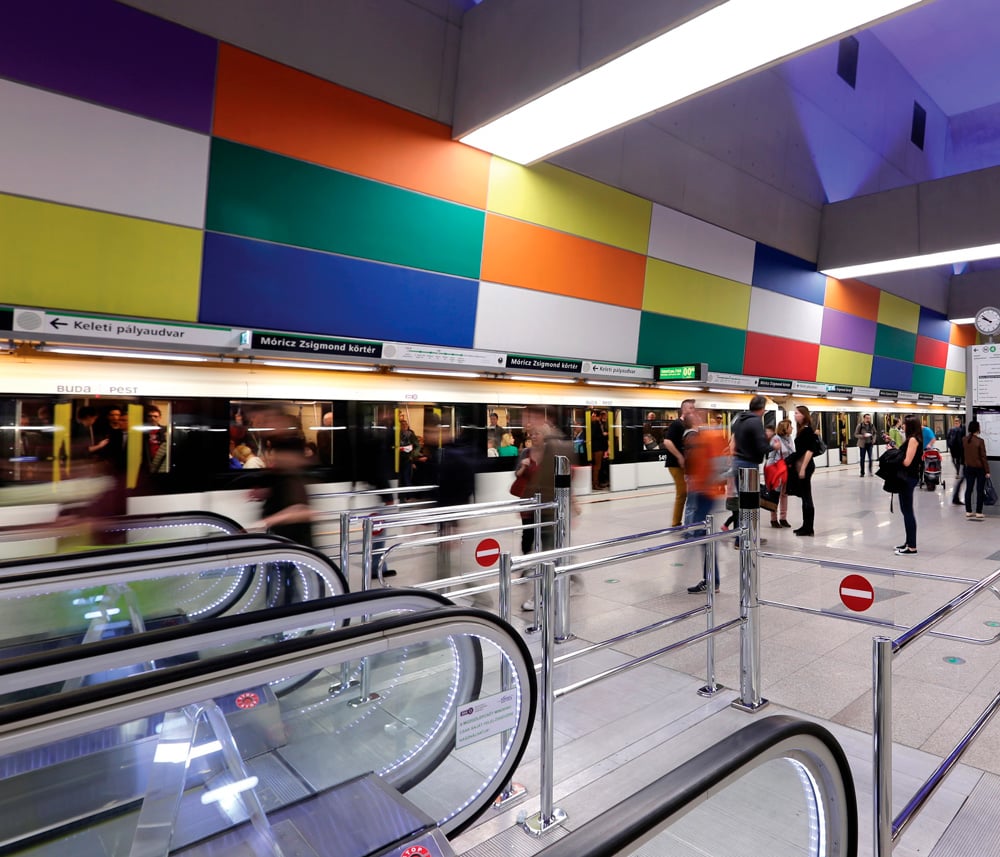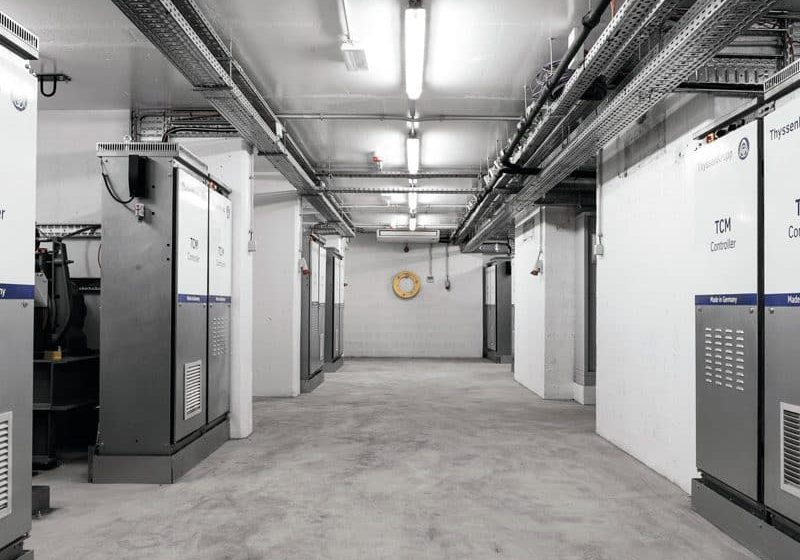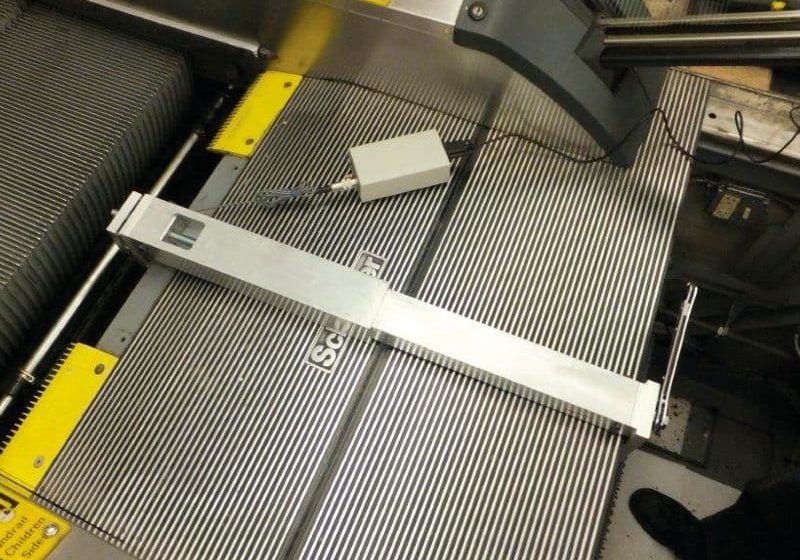Massive project blends technology, style and strength.
The Wittur Center of Competence in Zaragoza, Spain, assembled a team of specialists to tailor the vertical-transportation system for the new, fourth line of the Budapest Metro, a project that has been in the works since approximately 1970. The line’s 32 elevators were designed one by one before each component was built, then produced and delivered according to a tight schedule. A network of Wittur production facilities was involved: for system integration and production, Wittur Spain; for electric drives, Wittur Germany; for safety devices, Wittur Austria; and for cars, Wittur Turkey. Utilizing the complete Wittur network made it possible to achieve these extremely tailored elevators.
All 10 of line four’s stations are accessible thanks to the lifts, which are either machine-room-less (MRL) or outfitted with a machine room at the bottom. The Wittur team designed all units with 3D computer-aided design systems. All cars and car-door claddings are vandal resistant according to EN 81-71. Panoramic cabins enhance aesthetics, while Wittur gearless drives, door drives and components provide energy efficiency.
A Railway with History
The Budapest Metro is the oldest electrified underground railway system in Europe, and the second-oldest in the world, predated only by the 1890 London Underground. In fact, Budapest Metro line one was completed in 1896 and declared a United Nations Educational, Scientific and Cultural Organization World Heritage Site in 2002.
Budapest Metro currently features four lines. Line four runs southwest to northeast from the transit hub of Budapest Kelenföld railway station in the city’s most populous district of Újbuda, across the inner city district of Józsefváros to Keleti railway terminal. One of the biggest construction projects in the country in recent decades, the 7.4-km-long line began construction in March 2007 and was completed in March 2014. The project was realized through joint government and municipal financing.
While CNIM directly supplied 91 escalators for this huge project, the company looked for a reliable partner to design and build the 32 elevator systems that were an essential part of the tender.
Line four introduced many innovations, including internal design of the spaces, improved ventilation systems, passenger-information displays, full accessibility and automatic train control and monitoring. The train control, power supply and communications systems enable trains to run in fully automatic, driverless mode.
Natural Light and Accessibility
Line four’s architects used sunlight to illuminate platform areas wherever possible. For example, at Rákóczi tér, natural light reaches to the landing of the escalators at platform level through special light-conveying equipment programmed to follow the movement of the sun and reflect its light with movable mirrors. LED lamp fixtures were used for the artificial lighting of the stations.
Equipment was installed into the sides of the escalators to let blind and vision-impaired passengers know whether an escalator is moving up or down. Stations with one exit have four flights of escalators, while those with two have three flights each.
CNIM S.A. France supplied all transportation systems for the 10 stations. CNIM designs and produces turnkey industrial solutions for the environmental, energy, mechanical-engineering and transportation sectors. While CNIM directly supplied 91 escalators for this project, the company looked for a partner to design and build the 32 elevator systems that were an essential part of it.
At first, Wittur was tapped to supply only the components, and the Wittur team took over the complex and demanding task to develop tailored solutions for most of the different elevators. Later on, CNIM decided to source the complete packages of components, for all 32 elevators, by Wittur only; in this way they could manage this part of the project with just one interface and take it over starting from installation and commissioning.
All MRL systems are powered by Wittur S-series gearless drives.
All calculations were submitted and validated before production of each elevator. The team was able to react quickly to small changes in specifications made in the first stages of the project during analysis of each 3D drawing. One of the project’s goals was for the elevator systems to serve as both passenger and maintenance elevators. Therefore, additional stops were added on each system to allow technicians to access intermediate service floors. Additional car-operating panels with key locks were installed in the cars for technicians to access service floors.
All landing doors on the elevators have glass-framed panels, openings of 1000 mm and clear heights of 2000 mm. They feature stainless-steel, vandal-resistant cladding and are fire rated in compliance with EN 81-58. Certified car-door locks are International Protection code compliant. Heated sills prevent disruption of service due to ice or snow on street-level metro entrances.
All cars are vandal resistant according to EN 81-71. Car dimensions range from 1100 X 2100 X 2300 mm up to 2000 X 2100 X 2300 mm. Many cars were supplied with one or two glass walls to allow natural light to enter. Accordingly, many street-level entrances also use glass.
EOS Governors Enhance Safety
The use of electronic overspeed (EOS) governors in all systems helps ensure safety, as they detect not only overspeed, but also acceleration, and can trigger safety gears faster than traditional, mechanical overspeed governors. Unintended-car-movement protection devices were installed on all systems to prevent the car from moving away from a floor with landing doors unlocked and the door unclosed. This code-compliant system uses the EOS governor to detect unintended car movement and Wittur gearless drives with certified brakes to stop the car and keep it stopped.
Code-compliant, fire-rated Schaefer GmbH push buttons were used for all landing operating panels. To speed installation times, all cabling was supplied with fast-mounting terminals, including motor, traveling and shielded traveling cables.
All MRL systems are powered by Wittur S-series gearless drives supplied with Wittur gearless drive (GLD) frequency inverters to obtain an energy-efficient package featuring DC reactor, brake resistor, high-flow filter and harmonics-suppression filter.
The 2150-kg elevator at Fővrámtér station, the biggest in the project, is driven by a Wittur WSG-S 3.6 synchronous traction machine with a 480-mm traction sheave.
The 2150-kg elevator at Fővrámtér station, the biggest in the project, is driven by a Wittur WSG-S 3.6 synchronous traction machine with a 480-mm traction sheave. System automation was developed by Wittur and fine-tuned onsite to achieve a high-traffic, reliable solution capable of handling rush-hour traffic.
To sufficiently and safely evacuate passengers during emergencies, all lifts are equipped with either a double redundant power supply or a fully automatic, customized evacuation system. The system detects the presence of passengers in the car and evacuates starting at the top, outside landing, continuing as long as passengers’ presence is detected. All elevator controllers are equipped with full, remote-monitoring electronics for observation and problem diagnosis via intranet. Surveillance cameras inside cars are available, as well.
The use of GLD frequency inverters with the Wittur WSG gearless traction machines reduces energy consumption by up to 30%, versus traditional geared solutions.
One of the major challenges was coordinating the tight schedules of each team involved. In the end, all 32 systems were delivered and installed on time. After a few months of operation, the first feedback received confirmed the vertical-transportation system was in line with the metro’s expected performance, overall availability rate and maintenance budget.
Get more of Elevator World. Sign up for our free e-newsletter.










